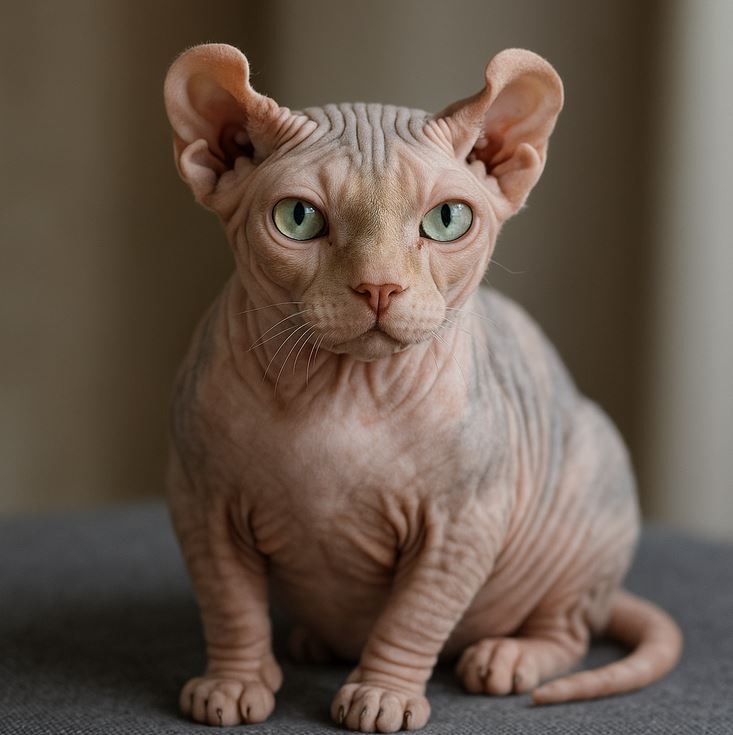Dwelf Cats Unwrapped: The Tiny, Curly-Eared, Hairless Charmers
From Idea to Experimental Status – A documented mid-2000s origin
The Dwelf is a purposeful blend of three breeds: Munchkin for short legs, Sphynx for hairlessness, and American Curl for the backward ear curl. The concept took shape in the United States in the mid-2000s. In 2006, TICA referenced Dwelf for the Experimental Registry rather than championship recognition. The project follows the 2004 creation of the Elf cat by Kristen Leedom and Karen Nelson, which combined Sphynx and American Curl without the short legs. Major registries such as TICA and CFA do not recognize the Dwelf for championship classes.
Varieties within the type – What can vary from litter to litter
 Ear curl: as in American Curl, kittens are born with straight ears that curl back as they mature, ranging from mild to pronounced.
Ear curl: as in American Curl, kittens are born with straight ears that curl back as they mature, ranging from mild to pronounced.
Leg length: litters may include short-leg (standard) and normal-leg (non-standard) kittens depending on inheritance.
Skin feel and appearance: from nearly hairless to a fine peach-fuzz down; all colors and patterns are possible because pigmentation shows on the skin rather than a full coat.
Physical profile – Size, build, head, ears, eyes, tail, skin
Size and weight: typically 4-9 lb (1.8-4.1 kg) and about 6-7 inches tall.
Body: long, low-slung, muscular, with a solid torso for a small cat.
Head and face: slightly longer than wide with pronounced cheekbones and a short, strong muzzle; whiskers and eyebrows may be sparse or absent.
Ears: large with rounded tips that curl backward; firm cartilage at the base with flexible tips.
Eyes: large, almond-shaped, in many colors.
Tail: long and tapering, sometimes with a small hair tuft at the tip.
Skin colors and patterns: any solid or pattern, including tabby, tortoiseshell, bicolor, and pointed or mink expressions.
What makes a Dwelf unique: the three-way signature of hairless feel, short legs, and back-curled ears in one cat.
Personality and everyday habits – Brainy, busy, and people-focused
Dwelfs are typically social, inquisitive, and playful. Expect a follow-you-around companion that enjoys interactive play, climbing, and puzzle toys. Compared with a typical domestic shorthair, many owners report a higher play drive and stronger desire for human interaction, traits commonly seen in Sphynx and American Curl lines.
Lifespan and health – What to watch and how to be proactive
Estimated lifespan is similar to other small companion cats when responsibly bred and well cared for.
Cardiac: from the Sphynx side, breeders often screen for hypertrophic cardiomyopathy with periodic echocardiograms.
Orthopedic/structural: from the Munchkin side, veterinarians discuss lordosis and pectus excavatum; responsible programs avoid problematic matings and monitor kittens closely.
Ears and skin: curled ears benefit from gentle, regular checks; hairless skin needs routine hygiene and protection from cold and sun.
Quick comparisons – Dwelf versus close cousins
Bambino: Sphynx × Munchkin – short legs, hairless, no ear curl.
Elf: Sphynx × American Curl – curled ears, hairless, normal legs.
Kinkalow: Munchkin × American Curl – short legs and curled ears, typically with fur.
Dwelf: combines hairless feel, short legs, and curled ears.
Fun facts – Name and rarity
The name blends “dwarf” and “elf.” As an experimental type, Dwelfs are rare and typically sourced from specialized catteries that document health testing and pedigrees.
Care tips for owners – Food, grooming, environment, and vet care
Diet: hairless cats often need slightly higher calories to stay warm; feed a complete, high-protein diet appropriate for life stage and activity level, with fresh water always available.
Skin care: wipedowns between baths and occasional gentle baths help manage natural skin oils; avoid over-bathing to prevent dryness.
Ear and nail care: check and clean ears regularly without forcing the curl; trim nails frequently to protect delicate skin.
Temperature and sun: keep indoors with warm resting spots and moderate sun exposure; use shade and common-sense protection for UV-sensitive skin.
Enrichment: provide vertical space, scratching options, wand play, and puzzle feeders for daily mental and physical stimulation.
Preventive vet care: schedule annual exams, discuss cardiac screening, and monitor posture and gait as the cat grows.
At a glance – Essentials for quick reference
Status: experimental type – not a championship breed with major registries.
Origins: United States, mid-2000s, following the 2004 Elf project.
Defining traits: hairless feel, short legs, curled ears.
Size and weight: about 6-7 inches tall, 4-9 lb (1.8-4.1 kg).
Temperament: social, intelligent, playful, people-oriented.
Owner focus: proactive health screening, skin-ear care, warm indoor lifestyle, and daily engagement.
Leave a Reply